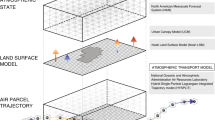Abstract
Local variations in the summertime mixing height over metropolitan St. Louis, Missouri, are examined in order to evaluate the dynamical and thermodynamical influences of an urban area. Case studies employing aircraft, lidar, pilot balloon and radiosonde data from Project METROMEX show variations in the height of a temperature inversion which caps a deep mixing layer. A dome-like lifting of the inversion structure occurs over the urban-industrial center with subsidence of the inversion layer at the perimeter of the metropolitan area. The maximum amplitude of the dome occurs shortly after mid-day, suggesting that thermal influences are primarily responsible.
Similar content being viewed by others
References
Angell, J. K. and Pack, D. H.: 1972, ‘The Kinematics of the Urban Wind Field and Some Forecast Implications’, Paper Presented at the Fourth Conference on Weather Analysis and Forecasting, Am. Meteorol. Soc., 17 pp.
Arnold, G. R.: 1964, ‘Local Inversions, Air Currents, and Smoke Pollution in Cahokia Bottom’, Sc. D. Dissertation, Sever Institute of Technology, Washington University, June, 192 pp.
Atwater, M. A.: 1971, ‘Radiative Effects of Pollutants in the Atmospheric Boundary Layer’,J. Atmospheric Sci. 28, 1367–1373.
Chagnon, S. A., Jr.: 1969, ‘Urban-Produced Thunderstorms at St. Louis and Chicago’,Preprints of Sixth Conference on Severe Local Storms, Am. Meteorol. Soc. 95–99.
Chagnon, S. A., Jr., Huff, F. A. and Semonin, R. G.: 1971, ‘METROMEX: An Investigation of Inadvertent Weather Modification’,Bull. Am. Meteorol. Soc. 52, 958–967.
Clarke, J. F.: 1969, ‘Nocturnal Urban Boundary Layer over Cincinnati, Ohio’Monthly Weather Rev. 97, 582–589.
Estoque, M. A. and Bhumralkar, C. M.: 1969, ‘Flow over a Localized Heat Source’,Monthly Weather Rev. 97, 850–859.
Fanaki, F. H.: 1971, ‘A Simulation of Heat Flow in the Lower Troposphere by a Laboratory Model’,Boundary-Layer Meteorol. 1, 345–367.
Hass, W. A., Hoecker, W. H., Pack, D. H., and Angell, J. K.: 1967, ‘Analysis of Low-level, Constant Volume Balloon (Tetroon) Flights over New York City’,Quart. J. Roy. Meteorol. Soc. 93, 483–493.
Huff, F. A. and Chagnon, Jr., S. A.: 1972, ‘Climatological Assessment of Urban Effects on Precipitation at St. Louis’,J. Appl. Meteorol. 11, 823–842.
Landsberg, H. E.: 1956, ‘The Climate of Towns’, inMan's Role in Changing the Face of the Earth, University of Chicago Press, 584–606.
Lawson, R. P.: 1972, ‘Urban-Induced Influences on Convective Cloud Activity’, M. S. Thesis, University of Wyoming, December, 168 pp.
Lettau, H.: 1969, ‘Note on Aerodynamic Roughness-Parameter Estimation on the Basis of Rough ness-Element Description’,J. Appl. Meteorol. 8, 828–832.
Malkus, J. S.: 1963, ‘Tropical Rain Induced by a Small Natural Heat Source’,J. Appl. Meteorol. 2, 547–556.
Morgan, G. M. and Beebe, R. C.: 1972, ‘Synoptic Analysis of Summer Rainfall Periods Exhibiting Urban Effects’,Preprints of Conference on Urban Environment and Second Conference of Biometeorology, Am. Meteorol. Soc., 173–176.
Munn, R. E.: 1970, ‘Airflow in Urban Areas’,World Meteorological Organization Technical Note No. 108, Urban Climates, 15–39.
Oke, T. R. and East, C.: 1971, ‘The Urban Boundary Layer in Montreal’,Boundary-Layer Meteorol. 1, 411–437.
Olsson, L. E., Tuft, W. L., Elliott, W. P., and McCormick, M. P.: 1971, ‘Observational Study of the Haze (Mixing) Layer in Western Oregon using Laser Radar, Instrumented Aircraft and Meteorological Balloons’, Paper presented at the 64th Air Pollution Control Association Annual Meeting, Atlantic City, New Jersey, 13 pp.
Peterson, J. T.: 1969, ‘The Climate of Cities: A Survey of Recent Literature’, National Air Pollution Control Administration Publication No. AP-59, Superintendent of Documents, Washington, D.C., 48 pp.
Slade, D. H.: 1969, ‘Wind Measurement on a Tall Tower in Rough and Inhomogeneous Terrain’,J. Appl. Meteorol. 8, 293–297.
Spangler, T. C.: 1972, ‘Dynamically Induced Meso-Scale Variations of the Urban Mixing Layer Depth’, Report AR104, Department of Atmospheric Resources, University of Wyoming, June, 30 PP.
Uthe, E. E.: 1972, ‘Lidar Observations of the Urban Aerosol Structure’,Bull. Am. Meteorol. Soc. 53, 358–360.
Viezee, W. and Oblanas, J.: 1969, ‘Lidar-Observed Hare Layers Associated with Thermal Structure in the Lower Atmosphere’,J. Appl. Meteorol. 8, 369–375.
Yamamoto, G. and Shimanuki, A.: 1964, ‘Profiles of Wind and Temperature in the Lowest 250 Meters in Tokyo’, Tohoku University, Science Report, Series 5,Geophysics 15, 111–114.
Author information
Authors and Affiliations
Rights and permissions
About this article
Cite this article
Spangler, T.C., Dirks, R.A. Meso-scale variations of the urban mixing height. Boundary-Layer Meteorol 6, 423–441 (1974). https://doi.org/10.1007/BF02137677
Received:
Issue Date:
DOI: https://doi.org/10.1007/BF02137677




